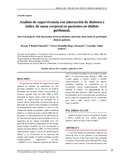Mostrar el registro sencillo del ítem
Análisis de supervivencia con interacción de diabetes e índice de masa corporal en pacientes en diálisis peritoneal.
| dc.rights.license | http://creativecommons.org/licenses/by-nc-sa/3.0/ve/ | es_VE |
| dc.contributor.author | Borges P., Rafael E. | |
| dc.contributor.author | Torres-Mantilla, Hugo Alexander | |
| dc.contributor.author | González-Villar, Andrea | |
| dc.date.accessioned | 2020-05-09T04:46:32Z | |
| dc.date.available | 2020-05-09T04:46:32Z | |
| dc.date.issued | 2020-05-09 | |
| dc.identifier.issn | 0543-517X | es |
| dc.identifier.uri | http://www.saber.ula.ve/handle/123456789/46759 | |
| dc.description.abstract | Se presenta un análisis de supervivencia para analizar los tiempos de seguimiento de 246 pacientes atendidos en el Servicio de Diálisis Peritoneal del Hospital Clínico Universitario de Caracas, seguidos entre los años 1980 y 1997, utilizando la muerte como evento de interés. El análisis de supervivencia fue efectuado de la manera clásica, incluyendo: (i) estimaciones de las funciones de supervivencia mediante el estimador de Kaplan–Meier para explorar el efecto en los tiempos de vida de los pacientes según el estado de diabetes y el índice de masa corporal (IMC) de los pacientes, (ii) determinación de las diferencias de las funciones de supervivencias mediante el test de logaritmos de los rangos (Log-Rank test), (iii) ajuste de dos modelos semiparamétricos de riesgos proporcionales (modelos de Cox) incluyendo la interacción entre diabetes e IMC, (iv) Selección del mejor modelo, según el criterio de información de Akaike y, (v) verificación de los supuestos del modelo seleccionado. El modelo definitivo resultó estadísticamente significativo (p-valor = 0,000177), no se violan los supuestos del mismo, y las covariables incluidas en este modelo son edad, IMC y la interacción entre diabetes e IMC, con p-valor iguales a 0,0015; 0,0072 y 0,0391, respectivamente, y los riesgos de muerte, estimados mediante el exponencial de su coeficientes fueron respectivamente 1,03138; 0,90166 y 1,02817. La interpretación de la interacción entre diabetes e IMC permitió ajustar un submodelo de Cox para pacientes no diabéticos en los cuales los exponenciales de los coeficientes para edad e IMC fueron 1,0371 y 0,8632, respectivamente. | es_VE |
| dc.language.iso | es | es_VE |
| dc.rights | info:eu-repo/semantics/openAccess | es_VE |
| dc.subject | Análisis de supervivencia | es_VE |
| dc.subject | estimador de Kaplan y Meier | es_VE |
| dc.subject | modelo de Cox | es_VE |
| dc.subject | diálisis peritoneal | es_VE |
| dc.subject | diabetes | es_VE |
| dc.subject | índice de masa corporal (IMC) | es_VE |
| dc.title | Análisis de supervivencia con interacción de diabetes e índice de masa corporal en pacientes en diálisis peritoneal. | es_VE |
| dc.title.alternative | Survival analysis with interaction between diabetes and body mass index in peritoneal dialysis patients. | es_VE |
| dc.type | info:eu-repo/semantics/article | es_VE |
| dcterms.dateAccepted | 1-9-2019 | es |
| dcterms.dateSubmitted | 1-7-2019 | es |
| dc.description.abstract1 | A survival analysis is presented to analyze the follow-up time of 246 patients of the Peritoneal Dialysis Service of the University Clinic Hospital of Caracas, followed between 1980 and 1997, using death as event of interest. The survival analysis was performed in a classical way, including: (i) estimations of the survival function using the Kaplan-Meier estimator to explore the effect of diabetes and body mass index (BMI) over the lifetime of the patients, (ii) determination of the differences of the survival functions using the Log-Rank test, (iii) the fitting of two proportional hazard semiparametric models (Cox models) including the interaction between diabetes and BMI, (iv) selection of the best model using the Akaike information criteria, and (v) the verification of the assumption of the selected model. The final model was statistical significant (p-value= 0.000177), there is no evidence of the violation of the assumption, and the covariables included were age, BMI, and the interaction between diabetes and BMI, with p-values 0.0015, 0.0072, and 0.0391, respectively, with a death hazard, estimated by the exponential of their coefficients 1.03138, 0.90166, and 1.02817, respectively. The interpretation of the interaction plot allowed to adjust a Cox submodel for the non-diabetic patient, and the exponential of the coefficients of this submodel were 1.0371 and 0.8632 for age, and BMI, respectively. | es_VE |
| dc.description.colacion | 3-13 | es_VE |
| dc.description.email | borgesr@gmail.com | es_VE |
| dc.description.frecuencia | Semestral | es |
| dc.description.paginaweb | https://saber.ula.ve/farmacia/ | es |
| dc.identifier.depositolegal | pp195802ME1003 | es |
| dc.identifier.edepositolegal | ppi201202ME4102 | es |
| dc.identifier.eissn | 2244-8845 | es |
| dc.publisher.pais | Venezuela | es_VE |
| dc.subject.facultad | Facultad de Farmacia y Bioanálisis | es_VE |
| dc.subject.institucion | Universidad de Los Andes | es_VE |
| dc.subject.keywords | Survival analysis | es_VE |
| dc.subject.keywords | Kaplan-Meier estimator | es_VE |
| dc.subject.keywords | Cox model | es_VE |
| dc.subject.keywords | peritoneal dialysis | es_VE |
| dc.subject.keywords | diabetes | es_VE |
| dc.subject.keywords | body mass index (BMI) | es_VE |
| dc.subject.publicacionelectronica | Revista de la Facultad de Farmacia | es |
| dc.subject.seccion | Revista de la Facultad de Farmacia: Artículos Originales | es_VE |
| dc.subject.thematiccategory | Medicina y Salud | es_VE |
| dc.subject.tipo | Revistas | es_VE |
| dc.type.media | Texto | es_VE |
Ficheros en el ítem
Este ítem aparece en la(s) siguiente(s) colección(ones)
-
Revista de la Facultad de Farmacia - Volúmen 61 (Especial)
Enero - Diciembre 2019


